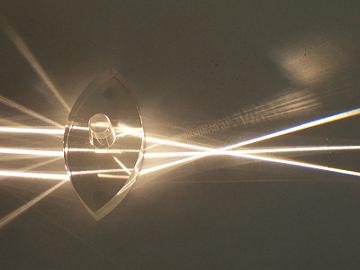[Great] things can be performed by refracted vision. The greatest things may appear exceeding small, and on the contrary; also the most remote objects may appear to be just at hand...
--Roger Bacon, Perspectiva 1267
 (Source: https://wiki.brown.edu/confluence/download/attachments/29221/convex%20lens.jpg)
(Source: https://wiki.brown.edu/confluence/download/attachments/29221/convex%20lens.jpg)
Light travels in straight lines through air. The speed of light differs when it passes through different materials; when it passes from one medium to another in which it travels at a different velocity, light appears to bend. This phenomenon called refraction, and occurs when light passes through mediums such as glass, plastic, and water. When refracted through a curved piece of glass, the further along the surface that the light enters the glass, the greater the angle at which the light is bent. Using a convex lens, light is refracted in such a way that an image will appear larger, whereas use of a concave lens will result in decreased image size. This property of light is exploited in lenses and magnifying glasses alike.
A Brief History of Optics
Initial encounters with light of ancient philosophers produced a plethora of observations but very little understanding of the phenomonon. Archimedes considered refraction in terms of astronomy and the atmosphere but was unable to quantify the phenomena. Plato, too, studied refraction, but it wasn't until Euclid that any concrete theories arose.
Euclid is often credited as the father of optics, who lived around 300 B.C.E. and established the first links between mathematics and the behavior of light. Hero of Alexandria and Ptolemy detailed the principle of refraction in second century B.C.E. through experiments which measured angles of refraction, creating tables from these measurements. Al-Haytham incorporated geometry into the study of optics, stressing the eye's importance as an optical apparatus. Alhazan wrote his Book of Optics which described the magnification and imaging properties of the eye and conceived of lenses and magnification. Concurrently with Alhazan, Shen Kua studied not only refraction but the employment of optical principles in tools in 1000 C.E. in China, making significant contributes not only to optics but other fields of study including magnetism (1). During the 13th century, Robert Grosseteste employed the study of refraction in order to understand the optical properties of a rainbow, situating light as central to understanding nature and physics. Bacon studied optics and furthered the understanding established by Grosseteste. Glass workers discovered the coverging lens which became used in spectacles during the 13th century, but not fully understood until the 16th century. Giovanni Battista Della Porta published popular optical texts in the 1500s which drew interest in optics from people other than expert scientists. Building on contributions made to optics by Dane Tycho Brahe, who studied the influence of optics on observation of the skies, Kepler's work employed refraction in order to establish astronomical laws, expanding on principles of optical science in the process. The telescope was produced by 1590 and employed by Galileo in his work.
The first archaeological evidence of an an object utilizing refraction was a found in an Assyrian “plano-convex piece of rock crystal,” from no later than 721-705 B.C.E. This rock crystal, although initially assumed to be an optical lens, was later dismissed as "quite unfit for optical purposes" by W.H. Dallinger after 1885. Other lens-like objects which have in more recent years been reexamined have been determined to be useless as magnifiers. A written account by Aristophenes describes use of globules of glass called “burning spheres” by the Greeks in the 4th century B.C.E. Pliny described Emperor Nero’s use of convex emeralds to view gladiator battles, although it is uncertain what the purpose of these might have been. In 13th century England, Roger Bacon conducted his work on optics and the use of spheres of glass as magnifiers. Spectacles were later developed in Florence, around 1280 by a disputed inventor. This particular utilization of optical principles provided a solution to the common problem of poor eyesight. Their wide-spread utilization allowed for a dissemination of optical knowledge beyond that of experts by end of 16th century.
(1) "Shen Kua." Wikipedia. http://en.wikipedia.org/wiki/Shen_Kuo#Mathematics_and_optics (12/12/08).
Back to The Basics of the Magnifying Glass
Posted at Dec 05/2008 04:14PM:
chris witmore: Great history. You might also mention the geometry of Thales, the optical tables of Hero of Alexandra and, later, al-Haytham, and, of course, Kepler (see Authier, M. 1995. Refraction and Cartesian 'forgetfulness'. In Serres, M. (ed.) A History of Scientific Thought. Oxford). This, of course, is the standard Western genealogy, but what of the Chinese strain? Have a look at the astronomer Shen Kua.
